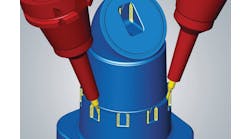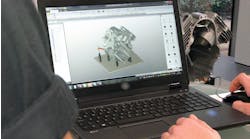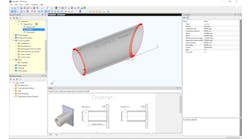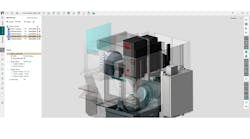COMPANIES AVOID MONEY PITS AND PUT PROFITS ON THE RISE WITH A REAL-TIME, PROFIT-ANALYSIS SOFTWARE SOLUTION.
Pinpointing the bottleneck operation and making it as efficient as possible is one of Maxager's goals.
Manufacturers don't always live up to their potential when it comes to achieving total available profit. This is due to a number of factors, including cycle times, resource utilization, yields, prices, product mixes, and raw material and production costs.
Maxager's system helps companies sell their capacity in the most profitable way. It can calculate profit figures based on products, teams, and operations.
With reports like these, jobshops can decide which product contracts are profitable and which ones are not.
Maxager Technology Inc. may be an unfamiliar company name to most, but its profit-chasing software program is sure to thrust the firm into the limelight. Maxager, located in San Rafael, Calif., has a system that uncovers hidden profit opportunities and points to lost profit in order to help component manufacturers achieve total available profit. After installing the system, many companies find that what they thought was a very profitable product, based on the amount made and the price charged, is actually a sink hole, while other marginal products offer better profit ratios.
Typically, profit is defined as revenue less cost. However, when lost profit (the opportunity cost of not producing the right product mix for the right price) is added to the picture, the resulting figure — total available profit — lets manufacturers know how much more they could be making.
According to Maxager, most current financial-analysis systems are designed for budget processes, inventory valuations, and product costing. Using these systems, managers know how much they made during the previous month or year. Although these systems translate units into dollars, they don't tell managers which products are winners and which ones are losers. As a result, sales and marketing managers form inaccurate conclusions about how to adjust the product mix and pricing strategy and where to invest more capital.
Maxager's system, on the other hand, offers minute-by-minute updates. Managers not only know exactly how much they are making but how much more they could be making and what changes are necessary to reach those untapped profits.
The system shows how and why profits fluctuate within a plant. It begins by pinpointing production bottlenecks that keep plants from maximizing their capabilities, and thus, capturing total available profit. Using this bottleneck operation as a foundation, the system prioritizes production issues by lost profit impact. For example, the software computes profitability as profit-per-minute instead of profit-per-unit. Consequently, managers can determine which products are truly more profitable to manufacture and sell on a minute-by-minute basis.
"Before, manufacturers had to make important marketing, production, and financial decisions without being able to measure how fast profit was flowing through their operations," says Michael Rothschild, Maxager's founder and CEO. "With continually updated total available profit reports, managers immediately see the impacts that their decisions have on the bottom line."
The Maxager System consists of a data station located at a key production point, most often the bottleneck or control-point operation. The data station has a color touch-screen and barcode interface and is customized for that specific area of production. Three seamlessly integrated modules, Opportunity Maxager, Margin Maxager, and Thruput Maxager, offer over 160 report possibilities for managers in various departments.
For example, Opportunity Maxager is of particular interest to financial management. The reports that fall under this module identify the problems that interrupt profit flow and cause losses. With Margin Maxager, marketing and sales managers can determine the best product line and pricing strategy for profit maximization, while Thruput Maxager, targeted for production managers, offers reports on machine utilization, scrap, work-in-progress, and cycle time. Using this information, managers can accelerate product flow through the bottleneck operation for a better profit-per-minute ratio. Essentially, Maxager lets managers know how to make the bottleneck operation as efficient as possible.
"Oftentimes, companies are spending scarce minutes of available capacity on unprofitable products," says Rothschild. "Our system lets companies know which products they should continue to produce and which ones they should discontinue."
As the data station monitors batches moving through the control point, the system takes seven factors into account: cycle time, utilization, yield, price, product mix, raw material cost, and overhead.
Through cycle time and utilization analysis, the system shows that products spending a lot of
time at the bottleneck operation have higher opportunity costs than those moving through it relatively quickly. For example, two products could have identical prices and raw material costs, but the one that moves through the bottleneck operation faster creates more money for the bottom line.
As for yield, the system finds the costs related to units scrapped. Units scrapped before the bottleneck don't cost manufacturers as much as units scrapped after the control-point operation. Any scrapped part, whether it occurs before or after the bottleneck, costs the company money and raw material, but those scrapped after this critical operation cost companies even more because they have lost time to the bottleneck operation that cannot be recovered.
Price and product mix are equally important factors. By determining the true profit for each product, the system lets management decide how to alter prices to increase revenue. The optimal product mix can also be determined.
Raw material cost is also continuously monitored because it is a constant variable. Finally, over-head or operating expenses are factored into the real-time reports. Products that take up more time at a constrained resource point absorb more overhead cost. Consequently, they decrease a manufacturer's opportunity to make a profit.
The proof is in the pudding
Rick Kulla, plant manager for Tool Products Co., in Minneapolis, reports that the Maxager software helps improve his plant's profit making efficiency. "Maxager gives us a real advantage in our highly competitive markets. With it, we know the actual dayto-day margins for each part and can adjust our operations, engineering, sales, and marketing efforts to maximize profitability."
Another company, Cast Alloys Inc., Northridge, Calif., has also drastically improved its operational efficiency and profitability using Maxager. Its manufacturing process entails over a dozen process steps. "With so many different processes, we had to connect production-cause and profit-effect," says Randy Kelch, executive vice president of manufacturing. "A change at one point can have a huge impact down the line. Maxager gives us real-time visibility into our business. We know where to put our priorities. As a result, our output, utilization, and profits have gone up."
The software helped Cast Alloys increase monthly cash flow by 67%, output by 91%, inventory turns by 23%, utilization by 13%, and reduce work-in-process inventory by 45%.
Maxager is even helping e-commerce suppliers maximize profits. Most e-commerce auction sites and individual transactions tend to favor consumers and not sup-pliers. So Maxager altered its program to help suppliers identify and bid on the most profitable orders based on the same profit-per-minute concept.






